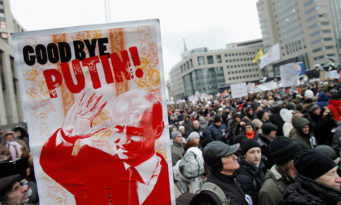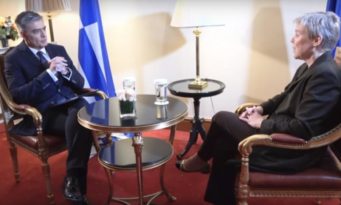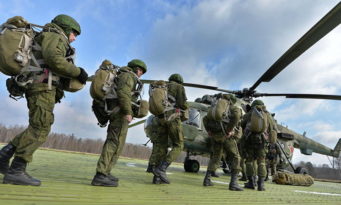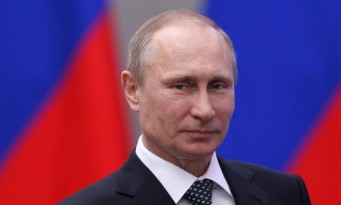NATO in the age of limited wars
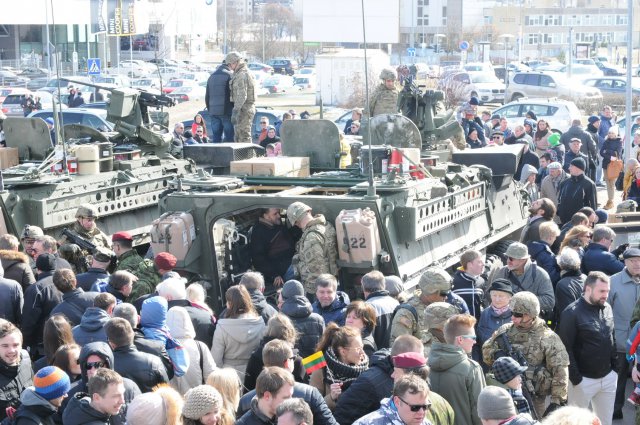
- By defencematters
Russia is using a type of warfare designed to exploit the vulnerabilities of the traditional NATO’s defense-in-depth posture.Jakub Grygiel and Wess Mitchell explain the implications for the small frontline states of the Eastern Flank.
by Octavian Manea
Russia is using a type of warfare designed to exploit the vulnerabilities of the traditional NATO’s defense-in-depth posture. Is the Alliance ready for deterring limited wars? Is the creation of the Wales super-rapid reaction force enough to reassure the Eastern allies? Jakub Grygiel and Wess Mitchell explain to us what the implications are for the small frontline states of the Eastern Flank.
- What is historically the role of limited wars in the context of broader geopolitical power transitions?
Jakub Grygiel: Historically there are two ways in which you can look at limited wars.
First, as a small local war meant to readjust some limited, precise territorial claim, but nothing beyond. Such wars of territorial adjustment had little or no systemic effects. Limited wars understood in this way did not fundamentally alter or re-arrange the balance of power. They were limited both in geography and scope.
The other limited war occurs when there is an ongoing change in the balance of power. There is a level of uncertainty about the new balance of power, and the state initiating a limited war is not sure about its own position in the system. It doesn’t want to start a large-scale systemic war because it may turn out to be too costly. A limited war is a good way to test how far it can go. In many ways, the first objective of a limited war is to avoid the big war while trying to gauge the resilience of the existing order. In this sense the significance of a limited war is different: it is a local war, but for larger regional or global purposes. If we can capture this in a bumper sticker it would be: act locally but think globally. It is to some extent what we see now happening in Ukraine: limited wars but with larger global repercussions.
Wess Mitchell: Limited war is a low cost, low risk method by which revisionist powers can accelerate geopolitical change to their advantage. It increases the burdens of the ordering power to wage an effective defense of the system. A limited war tests the capability or willingness of the hegemon to continue to project the deterrence upon which its alliance systems and leadership position have been based. The essence of limited war is to use a sufficient degree of force to achieve a significant political or territorial gain from the perspective of the revisionist, but remain beneath the threshold of military challenge necessary to trigger extended deterrence mechanisms or Great-Power war.
- What is the role of limited war in the spectrum of probes used by revisionist powers?
Jakub Grygiel: States that have revisionist intentions, but are uncertain about their position use limited war to check and probe how far they can go. Russia has chosen a violent form of probing. China prefers a more diplomatic, political and economic approach and so far has been very careful to avoid any type of violence. There are reasons for this. Russia sees a permissive environment in which violence can achieve much more and in a much quicker way than any other tool. Moscow is not abandoning the other tools at its disposal – political subversion or economic pressures. But Putin’s regime thinks it can get away with a more violent probing because of Europe’s political divisions and U.S. distraction and fatigue. China sees such an approach as being much more risky, much more costly.
The two revisionist powers have also a different perception of time. My sense is that Russia sees itself in decline and therefore it needs to act quicker than China. That is why the use of force in Ukraine and the threat of use of force in the wider European region are means to achieve quicker gains. China instead sees time on its side. Why use violence and generate opposition when in 10 years you may achieve things that you want in a much more peaceful, non-violent way?
Wess Mitchell: Limited war is an elevated form of probing. We see instances of determined, creative revisionist powers in history that use low threshold tests of the dominant power’s position in the international system that are aimed at its most vulnerable allies and span the spectrum of diplomatic and military tools. Limited war is at the military end of the spectrum and suggests that revisionists have concluded they have an enlarged space of maneuver. It is a significant step up on the escalatory platter from probes. You have the use of formal military force, an escalation of the amount of force and risk that the revisionist power is willing to take in order to prove the indefensibility of the status quo.
Limited war is an ideal method for an opportunistic revisionist who doesn’t want to spend a lot of energy to change the system, but just enough to demonstrate its indefensibility not only in the minds of other revisionist powers but also in the minds of indefensible allies themselves. The value of limited war from the perspective of the revisionist state is that it deepens the cleavages between the frontline states. It fuels accommodationist tendencies in frontline allies that do not want to risk a confrontation and leads them to implicitly free-ride on other states in the region like Poland, Romania, the Baltic states who do want to spend and do more.
- In a Europe where the use of limited war becomes more and more a tool of choice, are the decisions taken in Wales – like the creation of super-rapid reaction froce – appropriate to reassure the Eastern Flank?
Jakub Grygiel: The problem is that 48 hours or three days – the time necessary to organize and send a rapid reaction force – is too long for the type of potential action that Russia might engage in. In 2 days the Baltics are gone, were Russia engage in a limited war there. So the expeditionary force will not be there for defending the territory but it will need to re-conquer the lost territory, a task that is much more difficult operationally but also politically. This is a very different type of environment from that of 1914 or the Cold War when the type of threat presented allowed time to mobilize, stop or prevent a potential attack. Now time is compressed because the threat is no longer a traditional armored division marching through Poland which may take few days, but a small, local, quick limited war.
The second reason is that Russia may not engage in open military confrontation, but act under the threshold of NATO’s Article 5. There are multiple scenarios that one can conceive for such an action below the military horizon. And in this case, there may be very little political will among NATO allies to call for an expeditionary force. In brief, there are two problems we face: one is the timeframe of the threat, the other is the type of the attack that might occur. That is why the Wales summit had more of a rhetorical than practical impact. To deter against a limited war, it is necessary first and foremost to increase costs for the aggressor at the very outset of his operations – and this means to strengthen the ability of local forces to respond quickly and effectively. To promise a response hours, if not days, after the war has started (and in fact, when operations may have already ended, having achieved the purpose of the limited war), does nothing to shore up deterrence against this type of threat.
Wess Mitchell: If you accept the premise that limited war is what the Russians are using in Crimea and Ukraine, then certain things follow for NATO. Defense-in-depth is no longer a suitable posture, as this would merely grant low-cost land grabs to Putin in a future crisis. What is needed from NATO is preclusive defense -- the defense of a frontier that contests territory from the opening round. Essentially, local defense. NATO has taken some steps to move in that direction since the start of the conflict. It will be important that frontline member states not just pledge greater defense spending and preparation but actually do so. Recidivism is a danger. In terms of strategic reassurance there are many steps in the right direction like the prepositioning of equipment, creation of the spearhead force, and recent exercises like Dragoon Ride. But this is just a start.
The point of limited war is to create a territorial fait accompli using very small units that move very quickly, a sort of "jab and pause" technique. As long as NATO still has a basic posture that is defense in depth it doesn’t really matter how quickly a spearhead will arrive. The problem is that if you don’t have forward positioned assets Russia will be able to make these limited incursions with a fair degree of confidence that they will succeed.
- Is NATO’s traditional posture – one still focused predominantly in Old Europe – well suited to deter limited war campaigns on the Eastern Flank?
Wess Mitchell: The baseline problem for NATO is that its extended deterrence in its conventional form was not designed to counter Russian limited war. The last few years of steadily escalating probes have eroded extended deterrence in this region. Extended deterrence was not designed to counter limited war.
Limited war is - in some ways - the antidote to extended deterrence because triggering the latter requires a formal threshold of conflict that the former deliberately avoids. Limited war is designed to make it politically difficult for Western countries including the US to respond because it operates below that threshold. It's serious enough to challenge the status-quo but not serious enough to constitute a clear existential danger that would unify the West. This is a strategic problem of considerable magnitude and part of what it makes it difficult to address is that you can’t use the traditional methods of reassurance for exposed allies. You can’t use tripwires in the way that you used them in the past to counter limited war. The point of limited war is to avoid the confrontation with the larger power, create a fait accompli that is difficult to respond not only militarily, but politically. The problem is that it shifts the political ownership of the offensive to the defensive power. In that context the mission becomes one to evict not to deter.
Jakub Grygiel: NATO will continue to exist as a catastrophic insurance. If you do have ten armored divisions marching through Central Europe, if you do have a nuclear attack, NATO works. For everything else you end up with some sort of bilateral/regional arrangement among states that share a similar threat assessment and agree on security priorities. The coalition of the interested is the new normal.
- What should change specifically in NATO’s posture in order to become better positioned to deter a limited war?
Jakub Grygiel: The usual, and correct, answer is to reverse the defense spending cuts. Spend more! If you spend very little on defense, you can continue to claim that deterrence works, but if you can’t back it up, that claim is empty. Credibility without capability does not exist.
Also, NATO states have to start modernizing, buying and increasing their capabilities to respond to the specific nature of the threat, which is no longer related to out-of-area operations but is traditional territorial defense. This involves certain capabilities that may not have been considered over the past 10 years when the priority was to project power to distant regions, rather than to defend the homeland.
Third, something that you can do without even the previous two is to re-arrange the geographic disposition of the bases and forces. Germany and Italy, where a lot of U.S. forces are located in Europe, are not where the military threat is. The Baltic states, Poland, Rumania are the frontline states now, and U.S. bases ought to be located there in order to enhance NATO’s credibility and capability to deter any military attempt to revise the existing political order.
Wess Mitchell: The original sin of post-Cold War NATO is that from the time of enlargement the Alliance has maintained a lop-sided force posture concentrated in Western Europe where military power is no longer needed for territorial defense. This creates an uneven risk pool. The risk is spread disproportionately to exposed members of the Alliance, especially Poland, Latvia, Lithuania and Estonia. Capabilities are spread un-evenly and those that are at most risk have the weakest capabilities. This is a very bad combination. I don’t know of any alliance in history that has been based on an un-even distribution of risk and lasted for long. I don’t know how an alliance in that state can function if it is creatively challenged.
Crimea shows that we now have a very creative predator in the Eastern European ecosystem. It is not the predator that we have been expecting for the last decades in the NATO planning which was a conventional force, for which the alliance will have time to prepare a response politically as well as strategically. The military strategy of the Alliance is based on the idea of trading space for time. The Eastern quarter or so of its territory is under-defended. Ukraine is obviously not part of NATO but it is illustrative of a mid-sized state that utilized defense in depth against limited war and failed.
The problem with defense in depth against limited war is that you give to your opponent what he seeks -- territory for free. If you look at the Georgia and Ukraine wars and apply that template to a Baltic state the problem is that in a politically divided alliance by the time it has any semblance of political unity the Russians already have accomplished in the first 48 hours whatever territorial objectives they had, long before a spearhead force can arrive. What this suggests is that defense in depth doesn’t work against limited war.
- Crimea and Eastern Ukraine revealed a certain pattern of action. How should the defense strategy of the frontline states shift in order to project a credible deterrence?
Jakub Grygiel: For small frontline allies, the threat of a limited war raises important questions about the most appropriate response. Is it possible to have a purely defensive posture – to hold the border, so to speak? Or is it necessary to develop some sort of offensive capabilities, which would increase for the aggressor the costs of a potential attack? I am leaning toward the view that in order to defend yourself you might have to be able to project power inside the territory of the enemy. But we need to be careful how we think about this. Any offensive capability has the potential to escalate the conflict. You don’t want to escalate in an area in which you don’t have escalation dominance. Don’t pick a fight that you are going to lose.
But we need to keep in mind that small frontline states will not be able to deter by themselves. They’ll need the security guarantees from others. In the end the strategy that they need to pursue is to buy time, increasing the immediate costs for the enemy but also proving to the other allies that they can, and need to, join their defense. Here is where the so-called A2/AD component comes in handy: small allies should invest in capabilities that deny the aggressive revisionist a quick and easy success in a limited war. Combining this with some offensive platforms and doctrines, to enhance the ability to strike at the enemy’s staging and logistical areas as well as degrading its anti-air capabilities, increases the survivability of the small frontline state facing a limited war. By maintaining open access, a frontline state can also allow its allies to come into their territory to help. In other words, a defensive strategy of frontline states should be a combination of buying time and creating a permissive environment in which allied expeditionary forces can land.
Wess Mitchell: Part of the reason that small frontline states and local defenses are militarily more important is to avoid escalation. It is easier in the early phases of the violation of Lithuanian territory for Lithuanian troops to defend against these kinds of incursions than it is for NATO to try to use a defense in depth strategy. You have to have tripwires but this is not going to fully address the problem. We are in the era of local defense for Europe and that means that even small frontline states need to take the path of Poland and invest in real capabilities. Without serious defensive assets, and with NATO in its current posture, the Russians could seize NATO territory (for example, in the Kaliningrad-Belarus land corridor) and place the tactical and political burden on NATO to change that fait accompli against an opponent Alliance that faces a Russia that has a publically stated doctrine of escalate to de-escalate with tactical nuclear weapons.
Jakub Grygiel is a Senior Fellow at the Center for European Policy Analysis (CEPA) and the George H. W. Bush Associate Professor of International Relations at the School of Advanced International Studies (SAIS) of The Johns Hopkins University (Washington, DC).
A. Wess Mitchell is President of CEPA, a U.S. foreign policy institute dedicated to the study of Central Europe with offices in Washington and Warsaw.
The above are selections from a larger interview that is going to be published in Small Wars Journal
Photo Credit: US Army - U.S. Soldiers, from Lightning Troop, 3rd Squadron, 2nd Cavalry Regiment, convoy through Lithuania as part of Operation Dragoon Ride in Vilnius, Lithuania, March 22, 2015.







